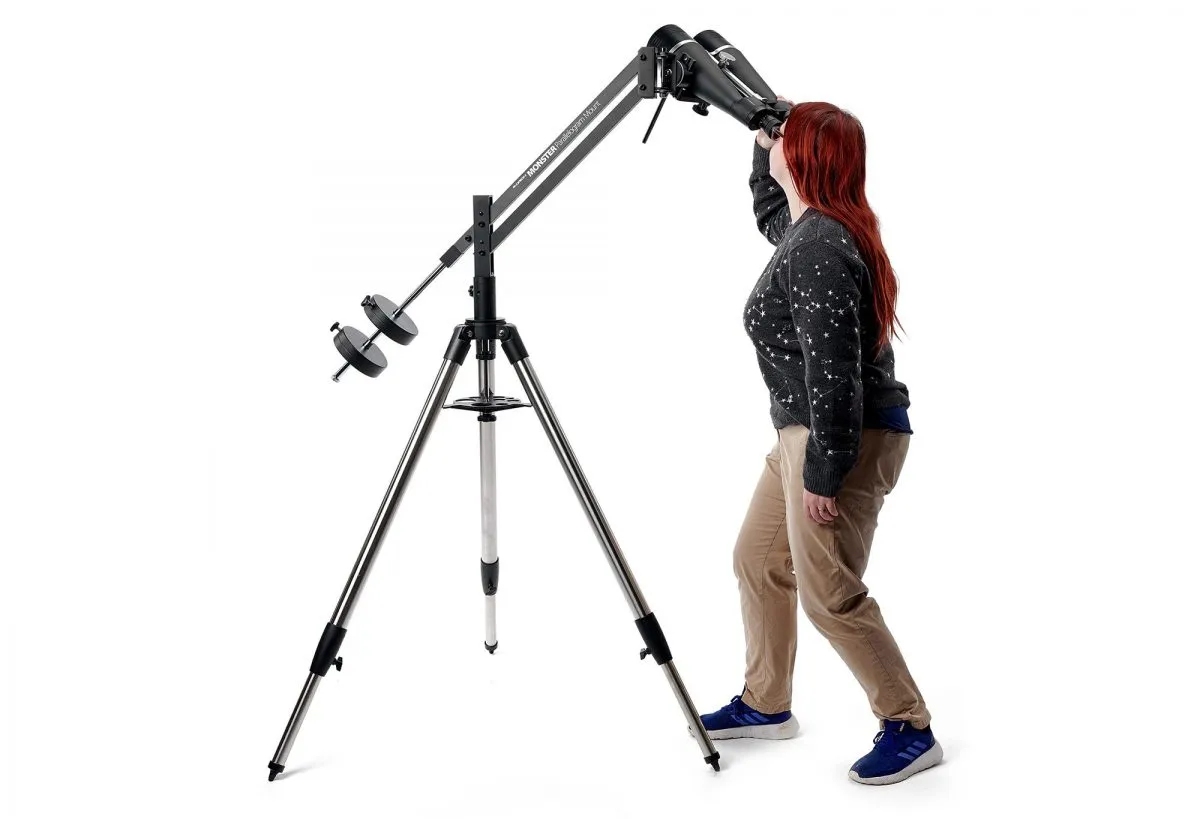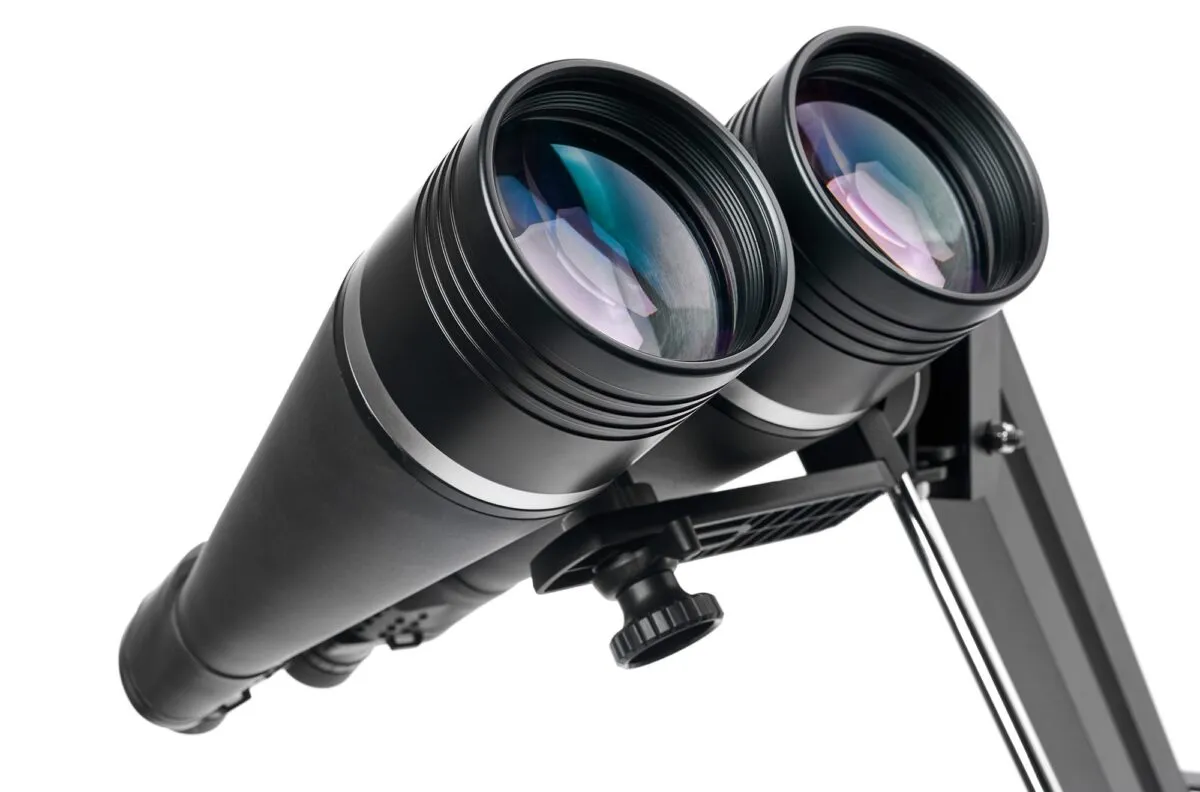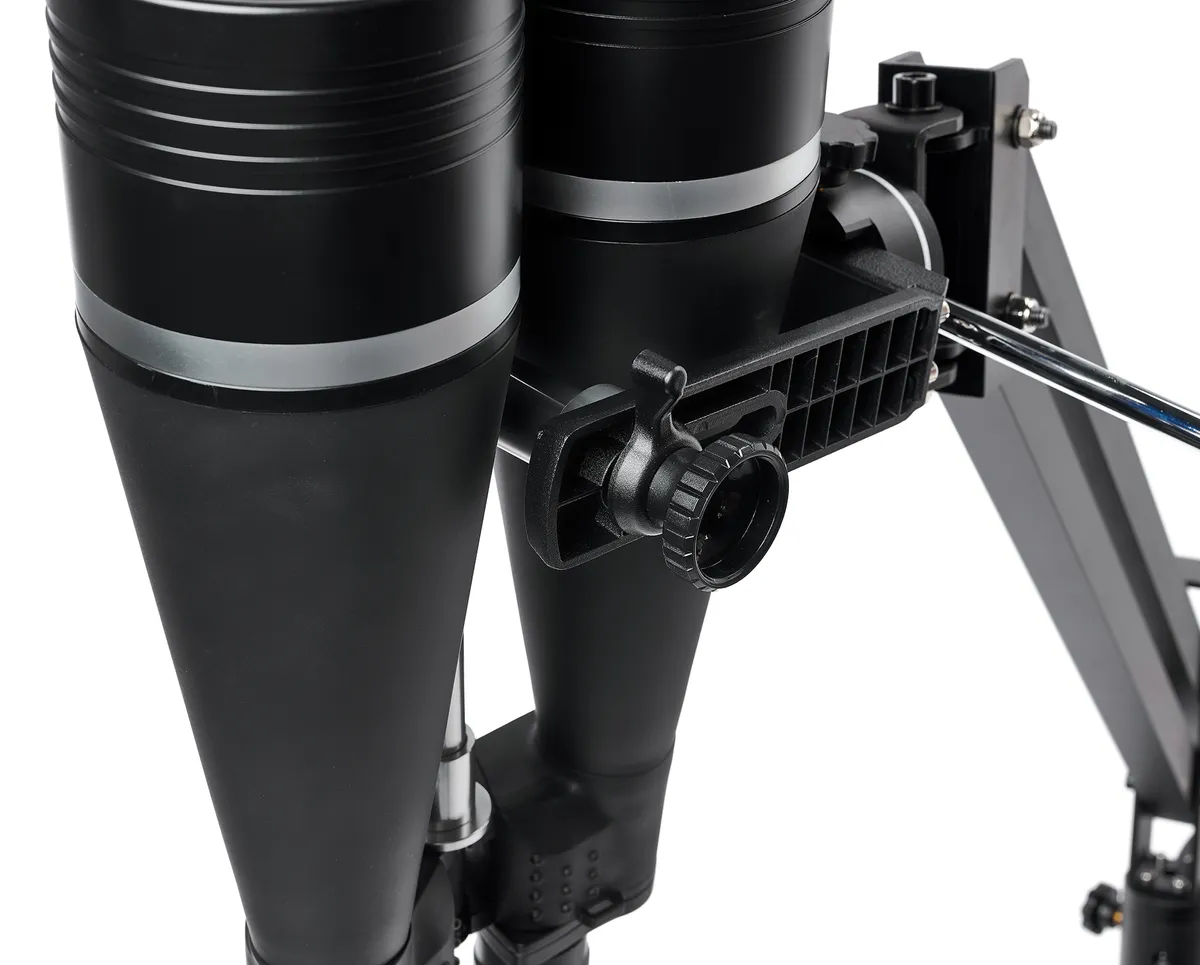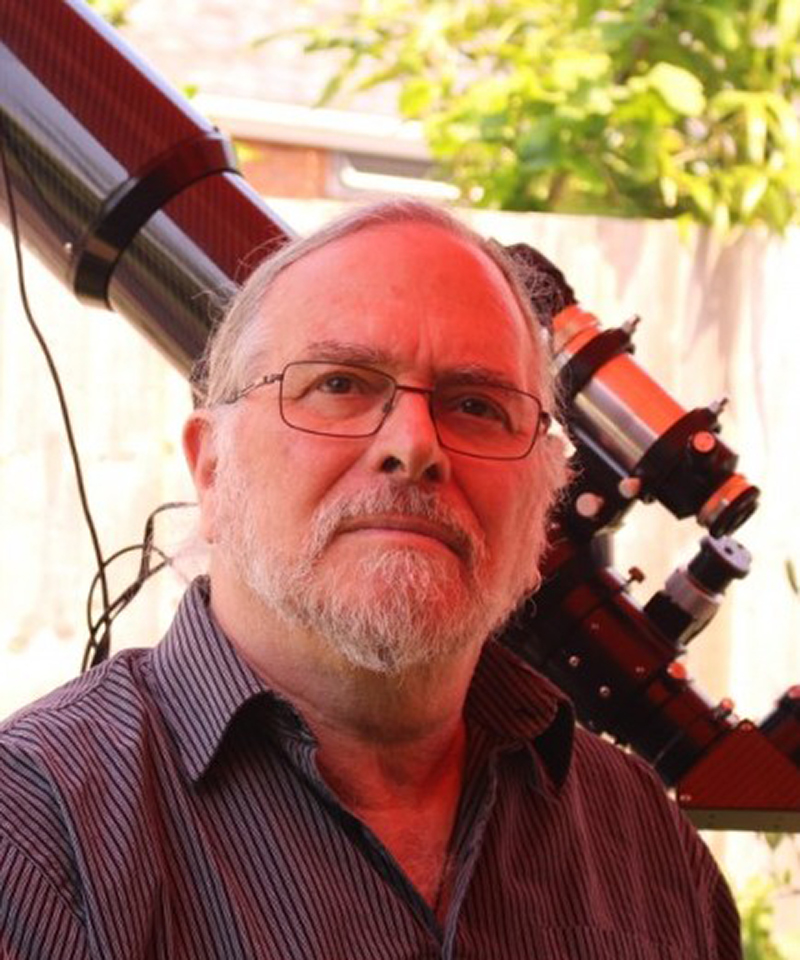Well-mounted large aperture binoculars are a joy to use, especially for the larger deep-sky objects, so Orion’s new binocular and parallelogram combo piqued our interest. The GiantView 25x100 binoculars, which come in an aluminium case, have a Porro-prism individual-eyepiece focusing design that is covered with a thin rubber armour.
There is a longitudinal bar that connects the hinge to cuffs on the objective cells. This bar increases the rigidity of the binoculars and carries a sliding mounting post that enables you to achieve perfect balance when you mount them.
But, at the point of perfect balance, it obstructs the minimum achievable interpupillary distance (IPD) – the distance between the pupils of your eyes – to 66mm.
When we looked down the objective tubes, we saw that the prisms are secured in proper cages, not merely clipped to the housing, so they should not become dislodged by minor bumps.
The entrance to the prism housing does not restrict the light path, so that light from the full 100mm aperture is transmitted to the eyepiece.
This examination also revealed that the insides of the objective tubes are smooth and without light baffles, although they are stepped where the objective tubes join with the objective cells and delete prism housings.
This means that stray light is not well controlled, to the extent that it is intrusive when, for example, a first quarter Moon is within about 5° of the target area of sky.
We didn’t notice this stray light from any stars, but it must cause some reduction in contrast.
These binoculars appear on our list of the best binoculars for astronomy and stargazing

We thoroughly enjoyed our first stargazing outing – as we put the binoculars and mount to the test – and targeted the constellation of Orion, the Hunter.
The Orion Nebula, M42, was bright, with a structure that seemed to increase in detail the longer we examined it.
The Trapezium Cluster was cleanly split as we moved it over the central third of the field of view. We found the colour rendition was very good with recently dimmed Betelgeuse looking ruddy.
We also tried some galaxies in Ursa Major: the Whirpool, M51, revealed both of its core structures, and the Pinwheel, M101, was easy to see despite its low altitude. Open clusters, however, are the real strength of these mounted binoculars.
While the Pleiades, M45, was as stunning as we expected, we spent a long time enjoying the Messier clusters in Auriga and Gemini and had to drag ourselves away from the Milky Way’s Cassiopeia region.
Given the weight of these binoculars, this enjoyment was only made possible by Orion’s Monster Parallelogram mount.
It has some nice touches, one of which is the facility to vertically adjust the mounting bracket in order to achieve perfect balance: you won’t find any positions in which the binoculars refuse to stay put without you over-tightening the mount’s joints.
This makes it easy to achieve that ‘floating binocular’ effect that is the hallmark of a good parallelogram mount. The helpful instructions are detailed and well-illustrated.

The tripod is a Synta-made model with 1.75-inch diameter legs, and a north pin (initially for equatorial mounts) which is used to prevent the parallelogram from unscrewing itself.
The mount arms measure 57cm between fulcrums, giving a vertical range of 75cm, making it easy to share views with people of various heights.
There is some vibration when you change target, but this dies down in seconds. There are two counterweights and you can experiment with their positions to achieve a short vibration-damping time.
When the binoculars are pointed vertically with the tripod extended, the eyepiece height is a maximum of 148cm. Orion suggests purchasing an extension pier for the mount, but you can use a garden recliner, as lying back makes high-altitude observing more comfortable.
This is a complete observing system that will suit anyone who wants a reasonably priced step-up to big mounted binoculars, using a mount that can take other astronomical instruments and which has the versatility to make it ideal for sharing the night sky with others.
Without any additional outlay, or using any tools, you can instantly adjust your mount for people of different heights, and the perfect balance of the binoculars ensures that they will still be pointed at the same target.
You can walk around the tripod, flitting from target to target, enjoying the variety of what these big objective lenses can show you or, as the mood takes you, pull up a garden recliner and, in comfort, examine an object or a region of sky in detail and depth.
The Vixen–Skywatcher compatible dovetail block on the mount not only enables you to achieve perfect balance of the 25x100 binoculars but, if you are wondering how the views in another instrument compare, it will also accept any compatible scope.

Locking lever
For security, it is essential that the attachment of the mounting post of these heavy binoculars cannot loosen while they are in use. The hand-wheel on the mounting bracket can give you reasonable tightness, but the locking lever, with mere thumb pressure, provides the extra security that you need.
Adjustable friction
Orion provides the instructions and tools to enable you to adjust the friction in the parallelogram motions. This enables you to set it low for the ‘floating binocular’ sensation, or to increase it for, say, windy nights or outreach events where it might be susceptible to being nudged.
Fully multicoated optics
Broadband multicoatings increase light throughput and also reduce the likelihood of internal reflections forming ghost images. They allow the maximum amount of light collected by the large objective lenses to pass to your eyes, giving you maximum brightness with a minimum of distracting ‘ghosts’.
Mini dovetail
Perfect balance requires that the load’s centre of mass is in line with the altitude fulcrum, which is usually impossible to achieve with L-bracket mounted binoculars. Orion has solved this by providing a mini-dovetail that enables the necessary forward-and-back adjustment, enabling perfectly balanced mounting of small binoculars.
Individual eyepiece focusing
For astronomical use, individual eyepiece focusing is considered to be superior to centre-focusing, largely because it is far less easy to accidentally change the focus. Once you are focused, you don’t need to refocus on different astronomical objects, so you don’t need the terrestrial convenience of centre-focus.
Vital stats
- Price £805.99
- Optics Fully multicoated
- Aperture and magnification 100mm, 25x
- Prisms BAK-4
- Angular field of view 2.5°
- Eye relief 18mm
- Interpupillary distance 61–72mm
- Focusing Individual eyepiece focus
- Mount load capacity 7kg
- Mount elevation range 75cm
- Weight Binoculars 4.6kg; mount and tripod 20.4kg
- Supplier Orion Telescopes & Binoculars
- Tel 0800 0418146
- https://uk.telescope.com/
This review originally appeared in the May 2020 issue of BBC Sky at Night Magazine.

